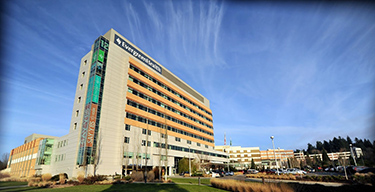|
Subscribe / Renew |
|
|
Contact Us |
|
| ► Subscribe to our Free Weekly Newsletter | |
| home | Welcome, sign in or click here to subscribe. | login |
Architecture & Engineering
| |
June 10, 2020
Hospital unit planned for EvergreenHealth gets redesigned to serve infectious patients
Journal Staff Reporter
In February, EvergreenHealth Medical Center was the first U.S. hospital to report a COVID-19 death, and subsequently received a lot of patients with the virus from the assisted-living facility Life Care Center of Kirkland.
Kevin Kajita, director of support services for the Kirkland hospital, said the hospital adapted 134 rooms so that potentially contaminated air stayed put and did not go into the corridors.
It did so by changing the controls on the HVAC system to draw air from the corridors into the rooms, where it was then exhausted out, said Garett Buckingham, director of design and construction with EvergreenHealth.
The hospital at 12040 N.E. 128th St. already had designed in the ability to transition 24 rooms in the Silver Tower on its campus to so-called negative pressure rooms in reaction to an earlier severe acute respiratory syndrome (SARS) epidemic, and still has those, he said. As the need has lessened from the COVID-19 surge, the other 110 rooms have been converted back to their original state.
In light of ongoing pandemic and its experience with SARS, EvergreenHealth is in the process of altering the design for a 20-bed critical care unit (CCU) it plans for the Silver Tower. The change in the scope of construction will go before its Board of Commissioners June 16, and construction is expected to start mid-month, Buckingham said.
The redesign allows EvergreenHealth to convert 16 traditional patient rooms in the CCU to negative pressure rooms when needed, said Chris Rubright, director of medical planning and a health care principal for San Francisco-based KMD Architects.
KMD is the architect and interior designer on the CCU, which will be built on a floor that is now shelled space. Notkin Mechanical Engineers, now owned by P2S, provided mechanical and plumbing design. Aldrich & Associates is the general contractor.
Rubright said EvergreenHealth had the KMD Seattle office where he works begin redesigning the mechanical system before contract negotiations were done for a construction bid that went out in February. The unit will also have four airborne infectious isolation patient rooms, also negative pressure, that will share anteroom buffer space as added insurance that contaminants don't get into the corridors.
Buckingham, with EvergreenHealth, said converting traditional patient rooms that have not been designed for it to negative pressure uses more energy and is more labor intensive than having rooms already set up for it, as they will be in the CCU.
He said the unit's redesign adds two new exhaust fans, rather than using the hospital's existing system, so Evergreen can make more rooms elsewhere in the hospital negative pressure if needed.
The CCU is estimated to cost $26.6 million, excluding the redesign of the mechanical system.
“It will allow us to serve the community around us whether it be a surge in COVID-19 or another pandemic issue,” said Buckingham.
During normal operations, traditional patient rooms would have a minimum of six air changes per hour (ACH), Rubright said, and maintain neutral or slightly negative air pressure relative to the corridor. The four isolation rooms would have a minimum of 12 ACH. In isolation mode, the other 16 patient rooms would also go to 12 ACH.
The KMD design has the contaminated air exhausted into HEPA filters, which trap the contaminants, including bacteria and viruses. As additional protection, ultraviolet light in the filtration system sterilizes particles.
People in negative pressure rooms may have multiple or more serious health conditions, such as diabetes and high blood pressure and weakened immune systems, that make them more susceptible to something like COVID-19, he said.
Patient rooms that can be converted to negative pressure cost less to build and take up less space (given the anterooms) than airborne infectious isolation rooms, he said.
The project team for the critical care unit also includes Lund Opsahl, structural engineering; Stantec, electrical and acoustic design; DIRTT, modular partition system; Wilson Jones Commissioning; and Dowl, civil engineering.
In San Francisco, KMD said it played a smaller role in assisting University of California San Francisco Health to complete Phase 1 of a 53-bed respiratory isolation unit to serve COVID and non-COVID patients. The firm said that, working rapidly and under an existing contract for other services, it provided planning support so 13 acute- and critical-care beds at its Mount Zion Hospital could open April 28. This is UCSF Health's primary site for caring for patients with novel coronavirus.
Fifty-five percent of KMD's work is health care design.
In light of the COVID-19 pandemic, Rubright said he would expect more health care facilities to want the flexibility to switch some of their traditional patient rooms to negative pressure.
“It's a more cost-effective way of providing for that surge in patients,” he said.
Lynn Porter can be
reached by email or by phone
at (206) 622-8272.



